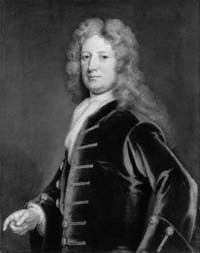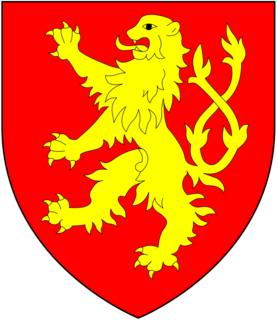Related Research Articles

Earl of Derby is a title in the Peerage of England. The title was first adopted by Robert de Ferrers, 1st Earl of Derby, under a creation of 1139. It continued with the Ferrers family until the 6th Earl forfeited his property toward the end of the reign of Henry III and died in 1279. Most of the Ferrers property and the Derby title were then held by the family of Henry III. The title merged in the Crown upon Henry IV's accession to the throne in 1399.

Baron de Ros of Helmsley is the premier baron in the Peerage of England, created in 1288/89 for William de Ros, with precedence to 24 December 1264. Premier baron is a designation and status awarded to the holder of the most ancient extant barony of the Peerage of England. The present premier baron is Baron de Ros. Before the Dissolution of the Monasteries the Prior of the Order of St John in England was deemed premier baron.
Baron Strabolgi is a title in the Peerage of England supposedly created in 1318 for Scottish lord David of Strathbogie, 10th Earl of Atholl. Despite lack of evidence supporting its existence, it was called out of abeyance by the House of Lords in 1916. Whether it ever existed before then is open to serious dispute.
Baron Burgh is a title that has been created twice in the Peerage of England. The first creation was for William de Burgh in 1327.

Baron Hastings is a title that has been created three times. The first creation was in the Peerage of England in 1290, and is extant. The second creation was in the Peerage of England in 1299, and became extinct on the death of the first holder in c. 1314. The third creation was in the Peerage of England in 1461, and has been in abeyance since 1960.

Baron Wharton is a title in the Peerage of England, originally granted by letters patent to the heirs male of the 1st Baron, which was forfeited in 1729 when the last male-line heir was declared an outlaw. The Barony was erroneously revived in 1916 by writ of summons, thanks to an 1844 decision in the House of Lords based on absence of documentation. As such, the current Barony of Wharton could more accurately be listed as a new Barony, created in 1916, with the precedence of the older Barony.

Baron Berners is a barony created by writ in the Peerage of England.
Baron Cromwell is a title that has been created several times in the Peerage of England. The first creation, which was by writ, was for John de Cromwell in 1308. On his death, the barony became extinct. The second creation came in 1375 when Ralph de Cromwell was summoned by writ to Parliament as Lord Cromwell. His grandson, the third baron, served as Lord High Treasurer to King Henry VI. However, on his death in 1455 the barony fell into abeyance between his nieces Maude and Joan. On Joan's death in 1490 the abeyance was terminated in favour of Maude, the fourth holder. When she died childless in 1497 the peerage once again fell into abeyance, this time between the daughters of the first baron. The title remained in abeyance for over 400 years. However, in 1922 the Committee for Privileges of the House of Lords reported in favour of the petition for the termination of the abeyancy of Selina Frances Bewicke-Copley. She was the daughter of Sir Charles Watson Copley, 3rd Baronet, and one of the co-heirs of Maud, daughter of the first baron Cromwell. Selina died in 1923 and in July of the same year the abeyance was terminated in favour of her son Robert Godfrey Wolesley Bewicke-Copley, who became the fifth baron. He notably served as Lord Lieutenant of Leicestershire. As of 2010 the ancient barony is held by his grandson, the seventh baron, who succeeded his father in 1982. Having lost his seat in the House of Lords under the House of Lords Act 1999, in April 2014 he was elected at a hereditary peers' by-election as a Crossbencher.

Baron Saye and Sele is a title in the Peerage of England held by the Twisleton-Wykeham-Fiennes family. The title dates to 1447 but it was recreated in 1603. Confusion over the details of the 15th-century title has led to conflicting order for titleholders; authorities such as Burke's Peerage and Debrett's Peerage do not agree on whether or not the 1447 creation is still extant.

Baron Strange is a title that has been created several times in the Peerage of England. Two creations, one in 1295 and another in 1326, had only one holder each, upon the death of whom they became extinct. Two of the creations are extant. All four baronies of Strange have been created by writ, which means that they can pass through both male and female lines.

Baron le Despencer is a title that has been created several times by writ in the Peerage of England.
Baron Furnivall is an ancient title in the Peerage of England. It was originally created when Thomas de Furnivall was summoned to the Model Parliament on 24 June 1295 as Lord Furnivall. The barony eventually passed to Thomas Nevill, who had married the first baron's descendant Joan de Furnivall, and he was summoned to parliament in her right. Their daughter, Maud de Neville, married John Talbot, who was also summoned to parliament in her right. He was later created Earl of Shrewsbury. On the death of the seventh earl in 1616, the barony fell into abeyance. The abeyance was terminated naturally in favour of the earl's daughter Alethea Howard in 1651 and passed through her to the Dukes of Norfolk. On the death of the ninth Duke in 1777, the barony again fell into abeyance. In 1913 the abeyance was terminated again in favour of Mary Frances Katherine Petre, daughter of Bernard Petre, 14th Baron Petre. Through her father she was a great-great-great-granddaughter of the ninth Baron Petre and his first wife Anne Howard, niece of the ninth Duke of Norfolk, who became co-heir to the Barony on her uncle's death in 1777. On Lady Furnivall's death in 1968 the barony fell into abeyance for the third time.

Baron Grandison was a title that was created twice in the Peerage of England, both times for men, brothers Sir Otho de Grandison and William de Grandison, who were summoned to Parliament in 1299. The barony created for Sir Otho became extinct on his death in 1328. The barony created for William fell into abeyance on the death of the fourth Baron in 1375. The present Paston-Bedingfeld baronet is a co-heir to the barony of Grandison, in recognition of which the arms of Grandison are sculpted on an oriel window at Oxburgh Hall.
The title Baron Bergavenny was created several times in the Peerage of England and once in the Peerage of Great Britain, all but the first being baronies created by error. Abergavenny is a market town in South East Wales with a castle established by the Norman lord Hamelin de Balun c. 1087.

The title of Baron Burghersh has been created three times in the Peerage of England.

The titles Baron Montacute or Baron Montagu were created several times in the Peerage of England for members of the House of Montagu. The family name was Latinised to de Monte Acuto, meaning "from the sharp mountain"; the French form is an ancient spelling of mont aigu, with identical meaning.

Baron St John of Basing is a former title in the Peerage of England. The family of St John of Basing in Hampshire and of Halnaker in Sussex was descended in the male line from the Norman Hugh de Port (d.1091) lord of the manor of Port-en-Bessin in Normandy who took part in the Norman Conquest of England in 1066, and was subsequently granted 53 manors in Hampshire. They had adopted the St. John surname by 1205.)
The title Baron Monthermer was created twice in the Peerage of England.
Baron Strange of Blackmere is an abeyant title in the Peerage of England. It was created on 13 January 1309 when Fulk le Strange was summoned to parliament. On the death of the fifth baron in 1375, it was inherited by Elizabeth Mowbray, née le Strange. On her death in the year 1383, it was inherited by Ankaret Talbot, née le Strange, daughter of the fourth Baron. On her son's death in 1419, the baron was inherited by Ankaret Talbot, his daughter. On her death in 1421, the barony was inherited by her uncle, John Talbot who was created Earl of Shrewsbury, Earl of Waterford and hereditary Lord High Steward of Ireland. On the death of the 7th earl in 1616, the barony fell into abeyance between his three daughters Mary, Elizabeth and Alethea. In 1651 Alethea became sole heir and therefore, Baroness Strange of Blackmere. The title continued in her descendants until the death of Edward Howard, 9th Duke of Norfolk and 22nd Baron Strange of Blackmere in 1777, when it again fell into abeyance. The co-heirs are the descendants of his nieces Winifred, Lady Stourton, and Ann, Lady Petre.

James Audley, 2nd Baron Audley of Heighley Castle, Staffordshire, was an English peer. He was the son and heir of Nicholas Audley, 1st Baron Audley (1289–1316) by his wife Joan Martin, who was the daughter of William Martin, feudal baron of Barnstaple, and Marcher Lord of Kemes. She was posthumously the eventual sole heiress of her brother William FitzMartin to Barnstaple and Kemes.